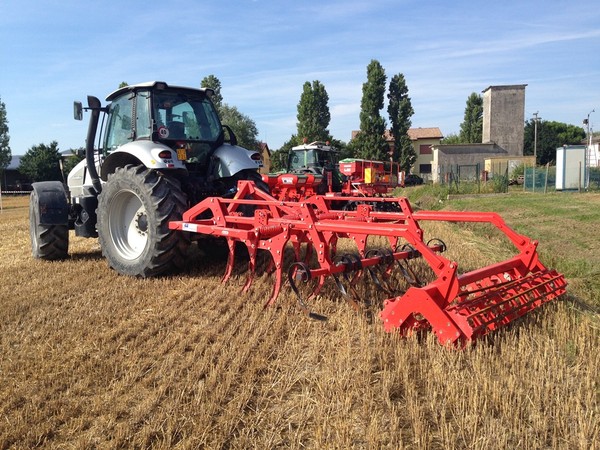
Greenhouse gas emissions and agriculture: the "AgriCare" project
Agriculture plays an important role in contrasting the dangerous effects of greenhouse gas emissions. It has been calculated that greenhouse gas accounts for, directly and indirectly, about one third of the total CO2 emissions. The LIFE AgriCare projects stands out among the research activities on the best agronomic techniques, which covers all phases of tillage and also involves equipment manufacturers. The research was carried out in collaboration with Veneto Agricoltura, Enea, the Padova University and the firm Maschio Gaspardo
The recent statements by Donald Trump on climate change are worrying: according to the US President the alarm raised by the COP 21 in Paris - the agreement is signed by all the countries in the world - is a “very expensive hoax” that must be ended. The refusal to tackle the causes of global warming on the part of the US President - the US is, after China, the country with the highest emissions of gases impacting climate - is in stark contrast with the position of the entire international scientific community.
Fortunately, although the risk of emulation of these paradoxical choices is high, attention to environmental protection is very strong, and many initiatives that aim to develop productive technologies and techniques able to contain as much as possible the impact on the planet’s ecosystems continue to be carried out. In the light of this, agricultural sustainability is extremely relevant. One need only consider the fact that it is estimated that on a global level about one third of CO2 emissions are caused, directly and indirectly, by current cultivation practices. It must also be kept in mind that the problem will tend to worsen: the exploitation of agricultural land will necessarily increase because of constant population growth on a global scale. The LIFE AgriCare project has been thought of to mitigate the impact the primary sector has on the environment. It aims to promote advanced techniques for precision agriculture combined with various conservation cultivation criteria. This approach will allow to consistently reduce energy consumption without reducing productivity, to cut CO2 emissions while favouring soil carbon sequestration.
The development of this project, coordinated by "Veneto Agricoltura”, the agency in the Veneto region for innovation in the primary sector, was made possible by the collaboration of qualified research institutions such as ENEA and the Padova University, and also involved Maschio Gaspardo Spa, one of the most important manufacturer of agricultural machinery.
Experimentation was carried out in some plots of land located inside the pilot company ValleVecchia - owned by Veneto Agricoltura - which constitute an agro-ecosystem of 800 hectares with a strong environmental and naturalistic value: the site has been identified as Special Protection Area (SPA) and Site of Community Importance (SCI) by Natura 2000, the EU network of protected areas, because of its rich biodiversity and variety of habitats. The work involved various rotation crops, corn, soybeans, rapeseed and wheat; the latter was cultivated using different techniques, conventional (for control samples), minimum tillage, strip tillage and zero tillage. With the exception of the conventional techniques - for which the following machines were used: plow, cultivator, rolling harrow, seeder, self-propelled sprayer - all conservation techniques employed machines equipped with automatic guidance systems, while distribution of seeds and fertilizer varied on the basis of georeferenced prescription maps (as will be explained further on). During the preliminary phase, data - subsequently updated - was gathered with regard to the following areas: the precise variability in production of different crops in time and space; The change in chemical and physical characteristic of the soil in the various areas interested (texture, skeleton, salinity, porosity, organic matter and humidity).
In order to produce GIS thematic maps on the abovementioned aspects, advanced technologies were used, such as drones for capturing images of the crops, or control sensors placed in the harvesters connected to satellite receivers that allowed localization inside the plot of land. Furthermore, these machines were also equipped with a sensor to record the quantity of the harvest and the percentage of humidity in the grains in the area where the measurements took place, and were integrated with a management system on board that allowed to record the collected data, geo-referencing it to the various locations inside the area. With regard to variability of the soil an accurate and easy to manage survey can be carried out also using on-the-go instruments such as conductivity sensors (electrical conductivity meters) or electrical resistivity sensors (geo-resistivity metres) that allow to carry out a rapid assessment of the properties of the soil along its profile. The final aim of this (and other) data collection is the creation of the abovementioned prescription map, that is a map of the area that provides, for specific portions of the fields, indications on how to behave during fertilization, sowing, irrigation, etc.
In practical terms, the moment the position receiver detects a tractor inside a specific area in which the dose to be delivered is different from the dose required by the previous portion of land, the computer on board will send a signal to the hydraulic or electrical actuators that will correct the actions of the operating machine.
Precision agriculture will increasingly allow to manage, in an intelligent way, the information concerning the variability of the productive, chemical and physical characteristics of the soil in a field. In fact, to implement precision agriculture allows to: maximize the performance of the operational machines, reducing fuel waste and time consumption; correctly dose seeds, pesticides and fertilizer in relation to the actual needs of the soil, effectively reducing the waste of these products.
In conclusion, the findings of the AgriCare project (www.lifeagricare.eu/it/) - which will be completed in May, 2017 - will be at the centre of a specific workshop held during the Agrilevante fair organized by FederUnacoma in Bari. On this occasion it will be possible to illustrate the criteria adopted to define the best choices and strategies for cultivation in order to increase productive efficiency while at the same time greatly lowering the environmental impact.
The goals of the AgriCare project
• ‑To test the potential of techniques of precision agriculture in terms of energy saving and reduction of emissions of environmentally harmful gasses;
• ‑To analyse the efficiency of the machinery used, equipped with electronic devices for precision agriculture, such as instruments to reduce emissions of CO2;
• ‑To examine the best scenarios for the diffusion of these techniques in various Italian agricultural contexts; also, to assess the relation between economic sustainability and environmental benefits;
• ‑To assess the long term effects of the technical innovations being tested using analytical models based on data concerning soil, machinery and climate and the analysis of the life-cycle assessment (LCA);
• ‑To test what has been examined and proved by the pilot project also in other areas, in order to encourage the diffusion of these technologies and techniques.








